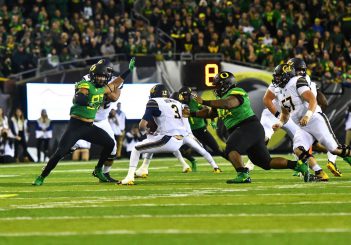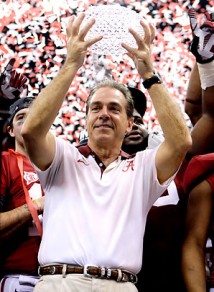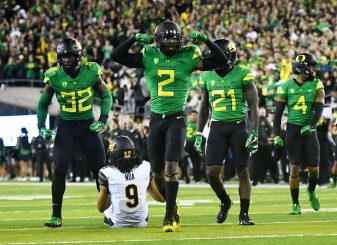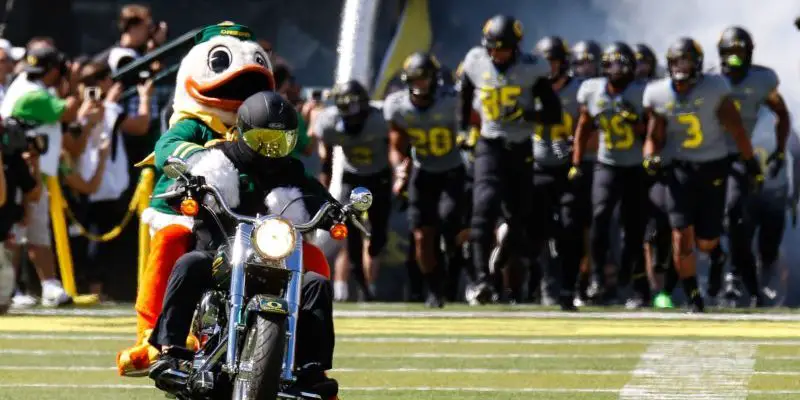It might seem silly to talk about dynasty the Monday after a disastrous victory against California. Just as the Ducks started to look competent on both sides of the ball, Justin Herbert, Royce Freeman, and Dillon Mitchell suffered injuries. All of this coming at a time when the Ducks are already thin at quarterback (Herbert’s backup wasn’t practicing at quarterback during spring) and wide receiver (the depth chart includes two converted defensive backs). But the Ducks, more importantly, are beginning the difficult stretch of their schedule.
Despite the momentary gloom, the Oregon program under Willie Taggart is looking up. Five games into the season, Taggart and Co. have won as many games as the Ducks won all last year. Second, the defense was heroic against California. And while the defense showed momentary flashes, even during the doldrums of recent seasons, there are signs of real improvement under Jim Leavitt and Joe Salave’a.

Jalen Jelks and Jordon Scott meet at the quarterback.
Marginal improvement, however, is not the goal. Taggart says he wants to win a national championship. Technically, the goal of every college football program is to win the national championship each year. And while Ducks fans would be happy with just one championship, “Duck Dynasty” is the ultimate goal.
“Dynasty” should be defined as a team that is perennially in the College Football Playoff conversation. By that definition, Nick Saban and Urban Meyer have established dynasties at Alabama and Ohio State, respectively.
College football dynasty is different from NFL dynasty because inertia plays a bigger role in college. Unlike the NFL with its draft and salary cap, the NCAA applies no talent equalizer, and successful teams get the best recruits. In other words, dynasty creates a snowball effect.

Nick Saban celebrates.
There are three elements to establishing and maintaining dynasty: talent acquisition and development, Xs and Os innovation, and retaining and replacing coaching staff.
Talent – Recruiting and Development
At its root, football is a game won or lost in moments of one-on-one physicality. Without good players, a team cannot win. Every coach tries to get the most out of his players; Oregon has been famous for this. But coaches can do only so much with poor talent. Dynastic talent is achieved in two ways: recruiting and development.
First, recruiting brings talented players through the door. Every year, Saban and Meyer bring in the building blocks for their next great team; since 2012, only once has either team finished outside the top 5 in recruiting class rankings (Ohio State was 7th in 2015). As I discussed in my previous article, both Alabama and Ohio State have geographic recruiting advantages over Oregon (more good players close to campus), but Taggart has recruited well (great finish to the 2017 recruiting cycle, with many freshmen already contributing; and a top-5 2018 class so far).
After getting players in the program, the hard work of turning them into college players begins. Part of the development is physical and in the weight room. Another part is to help players develop proper mechanics and technique. But coaches must also mold players mentally. All this requires coaches with deep knowledge, along with communication skills.

The defense has new swagger.
It is too early to judge Taggart and Co. on player development. But early signs are positive. Many true freshmen are already playing and contributing. Better still, veteran players show dramatic improvement. Arrion Springs, for one, looks to be much better, and Tyree Robinson was playing the game of his career prior to his targeting penalty. Also, the defensive line has come alive under Salave’a. (How ’bout Jalen Jelks!) It’s impossible to say those players wouldn’t have made similar improvements under the old staff, but their development trajectory appears altered.
X’s and O’s Innovation
Sustained success in football requires innovation of game plans and strategy. This point is simple. Opponents are continually studying to stop the Oregon offense and exploit their defense. If the Ducks run the same plays over and over, opponents will diagnose them and they will lose games. So, football requires constant innovation on both sides of the ball.
As Charles mentioned last week, part of Oregon’s historical success was X’s and O’s innovation. Chip Kelly memorably transformed college football offenses through this disruptive innovation to create the Oregon offensive juggernaut. Even Mark Helfrich, who struggled at many things, continued the innovation on offense. Taggart, for his part, showed the willingness to innovate when, at South Florida, he shifted from a pro set to his own “Gulf Coast” design.
On defense, Jim Leavitt is an innovator in his own right. FishDuck.com has published many articles about his innovations: here, here, here, here, here, here and here.
Assistant Coaches – Replace and Retain
Both talent acquisition and development and X’s and O’s innovation depend on having good coaches. Neither Alabama nor Ohio State depend on their assistant coaches staying around for long. Prior to firing the whole coaching staff after last season, Oregon had been an outlier regarding the longevity of its staff. At Alabama, only one of Saban’s assistants, Burton Burns, coached with the program prior to 2015. The story is similar at Ohio State. Only two coaches remain from Meyer’s first staff in 2012.

Urban Meyer
Dynastic football programs are the training grounds of future head coaches and coordinators. The downside is that other programs poach their assistants. Seven current head coaches were Saban assistants (including two in the NFL). Meyer can boast of nine. The key for both Alabama and Ohio State has been that they have been able to replace the coaches they lose with new assistants who integrate into their systems and continue the teams’ success.
In his first season, Taggart compiled an impressive coaching staff. Much of my trust in Taggart is due to the wisdom and tenacity he displayed in acquiring it. However, such a great staff, if successful, won’t stay together for long. Duck fans should worry, especially about departures of Leavitt, Salave’a and Mario Cristobal. Both Leavitt and Cristobal have been head coaches in the past, and assistant head coach Salave’a has the ambition to be a head coach. Key to establishing a Duck Dynasty will be replacing these great coaches with more. Taggart has shown the ability to identify quality coaches, but can he keep doing it?
Dynasty in the Making
As Taggart and Co. recruit and develop talent, depth will be less of an issue, and a series of injuries like that sustained against Cal will hurt less. Oregon is also finally innovating on both sides of the ball and has a shot at keeping up with the X’s and O’s arms race in the Pac-12. However, it remains to be seen whether Taggart can adequately replace his world-class assistants as they are inevitably poached. Regardless, Oregon is showing signs of a dynasty in the making.
Cody Lonning
Cheney, Washington
Top photo credit: Gary Breedlove
Related Articles:
Oregon Enters Playoffs Better Off Than Last Year
Will The Coaching Carousel Kill Oregon's CFP Chances?
The Playoff Formula Hasn't Changed
Oregon Aims to Bury Dawgs, Punch Playoff Ticket in Rivalry Clash
Huskies Are the New Beavers, Stay In Your Lane Kiffin, and the Civil Apple Cup War
Oregon Football: The X-Factor Vs. Washington
Cody inherited all his sports allegiances from his grandfather, a long-time Eugene resident. Even though Cody graduated from law school at Berkeley, he remains a staunch Oregon fan. When he isn’t watching the Ducks, Cody is hiking, engaged in various home-improvement projects, or writing about politics. Cody grew up farming hay and wheat in Eastern Washington. Now, he practices law.

